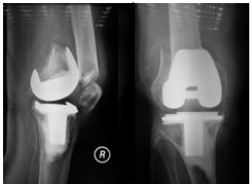Assessment and management of peri-prosthetic fractures
by James Donaldson
|
Hip peri-prosthetic fracture
History Age – elderly, often low energy. Increasing in incidence Original surgery – when, indication, surgeon, complications (infection) Early – within 6 months of surgery. Often uncemented components Late – beyond 6 months of surgery Past medical/surgical history Medication/drugs and allergies Radiographs / Imaging:
|
Signs & Symptoms
Pain, swelling, rotational deformity of leg
Unable to weight bear
Risk factors
Elderly
Osteoporosis
Poor bone stock
Revision surgeries
Uncemented femoral prosthesis
Initial treatment
Similar to neck of femur fracture
Analgesia, O2, IV fluids
Skin traction for comfort
Admit for surgery
Classification (Vancouver)
A – fracture in trochanteric region
B – fracture around the stem
B1 – good bone and well fixed stem
B2 – loose stem but good bone
B3 – loose stem and poor bone stock
C – fracture distal to the tip of the stem
Definitive management
Nearly all need operative fixation (unless medically moribund or completely undisplaced type A)
Fixation with wires, cables and plates
Revision prosthesis in B2 and B3 types
Proximal femoral replacement is another option in the elderly and less mobile where immediate mobility is preferred
Pain, swelling, rotational deformity of leg
Unable to weight bear
Risk factors
Elderly
Osteoporosis
Poor bone stock
Revision surgeries
Uncemented femoral prosthesis
Initial treatment
Similar to neck of femur fracture
Analgesia, O2, IV fluids
Skin traction for comfort
Admit for surgery
Classification (Vancouver)
A – fracture in trochanteric region
B – fracture around the stem
B1 – good bone and well fixed stem
B2 – loose stem but good bone
B3 – loose stem and poor bone stock
C – fracture distal to the tip of the stem
Definitive management
Nearly all need operative fixation (unless medically moribund or completely undisplaced type A)
Fixation with wires, cables and plates
Revision prosthesis in B2 and B3 types
Proximal femoral replacement is another option in the elderly and less mobile where immediate mobility is preferred
|
Knee peri-prosthetic fractures
History Age – elderly, low energy injuries Similar to peri-prosthetic hip fractures Radiographs:
|
Symptoms and Signs
Pain, swelling, bruising, deformity
Inability to weight bear
Supracondylar femur fracture
Risk factors include
Osteoporosis
Rheumatoid arthritis,
Steroids
Notching of the femur (sawing into the anterior cortex during the initial procedure)
Osteolysis
Initial treatment
Analgesia, O2, IV fluids
Skin traction for comfort
Admit for surgery
Definitive management
Operative treatment is usual
Tibial fracture
Less common than femoral fractures
Risk factors include
Surgical fixation is with a long stem revision tibial component or ORIF if the component is stable
Patella fracture
Manage as per patella fracture section (generally requires fixation unless undisplaced)
Pain, swelling, bruising, deformity
Inability to weight bear
Supracondylar femur fracture
Risk factors include
Osteoporosis
Rheumatoid arthritis,
Steroids
Notching of the femur (sawing into the anterior cortex during the initial procedure)
Osteolysis
Initial treatment
Analgesia, O2, IV fluids
Skin traction for comfort
Admit for surgery
Definitive management
Operative treatment is usual
- Fixation with a plate or a retrograde femoral nail (need to know the prosthesis design prior to nailing)
- A distal femoral replacement can also be used in the more elderly and less mobile
Tibial fracture
Less common than femoral fractures
Risk factors include
- Long stem
- Loose tibial component
- Osteolysis
- Malalignment
- Revision surgery
- Tibial tubercle osteotomy
Surgical fixation is with a long stem revision tibial component or ORIF if the component is stable
Patella fracture
Manage as per patella fracture section (generally requires fixation unless undisplaced)


